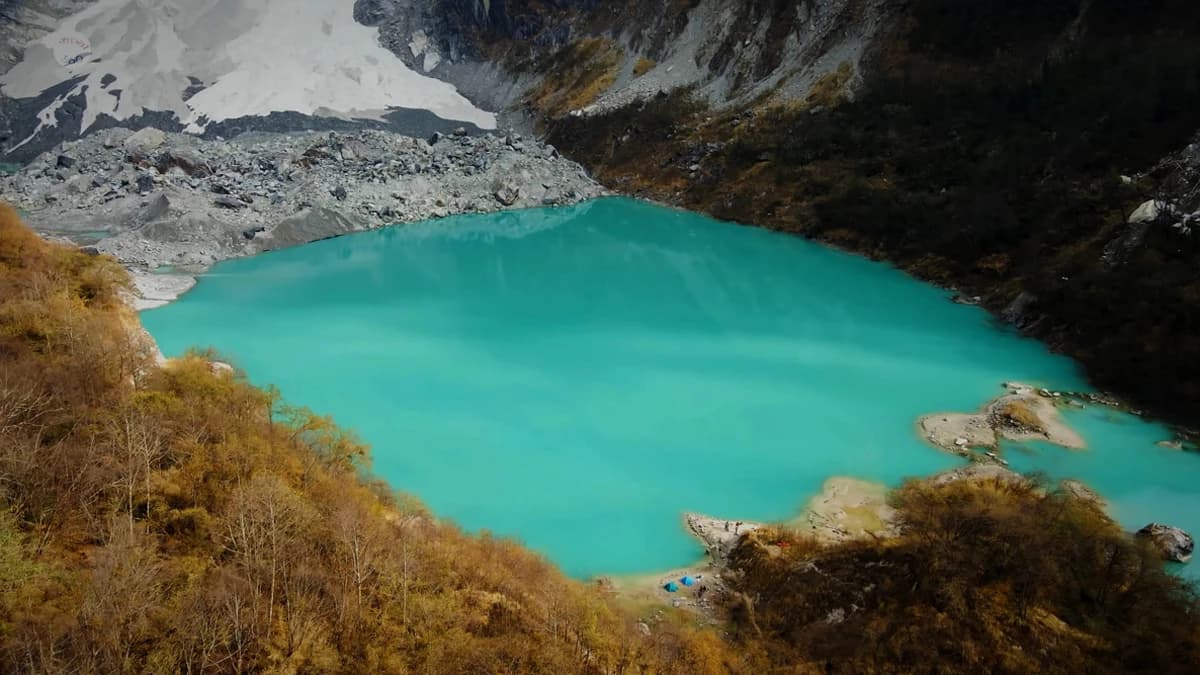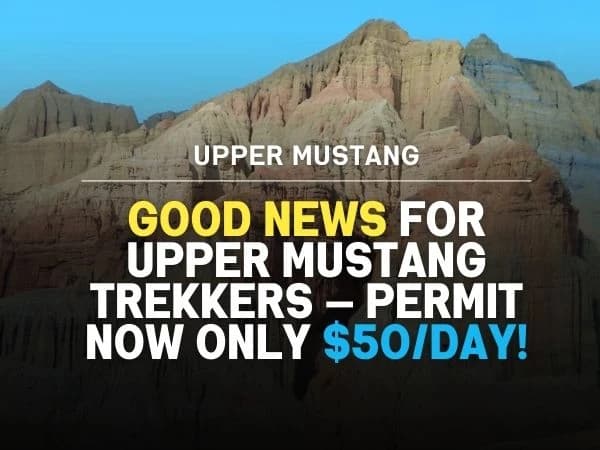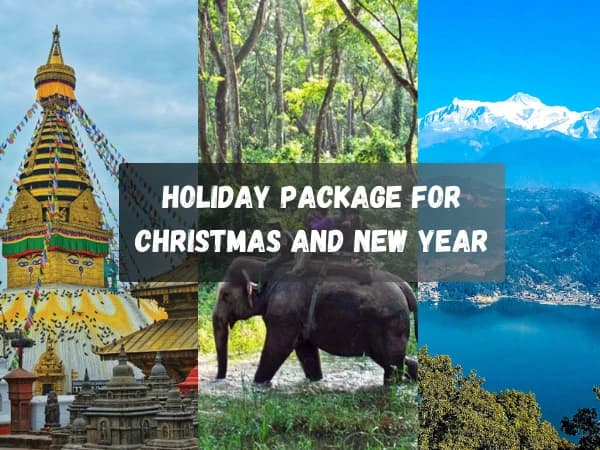Kapuche Lake Trekking is an incredible adventure that takes you through the beautiful landscape of Nepal, Often referred to as the “Lowest Glacier Lake in Nepal". You’ll have the opportunity to witness the majestic the Annapurna range, explore lush forests, and experience the serenity of kapuche lake. Its a trek that offers both natural beauty and cultural immersion.
Kapuche Lake Trekking – Lowest Glacier Lake in Nepal
Kapuche Lake Trek Highlights:
✔ Picturesque drive to Armala.
✔ Cultural immersion in Thak Village.
✔ Panoramic views from Tara Hill Top.
✔ Exploration of culturally-rich Sikles Village.
✔ Peaceful nights at Hugu Goth.
✔ Mesmerizing Kapuche Glacier Lake visit.
✔ Diverse trekking terrains.
✔ Insights into local traditions and customs.
✔ Chance to spot local wildlife.
What Kapuche Lake Trek Has to Offer?
The history of Kapuche Lake is as intriguing as its natural beauty. Local legends speak of its sacred significance, and over the years, it has become a sought-after destination for both trekkers and spiritual seekers.
Kapuche Lake Trekking is not just another trek; it’s a journey that promises unique experiences at every turn. The trek offers a blend of natural beauty, cultural insights, and spiritual rejuvenation.
Here’s what awaits you on this mesmerizing journey:
• Spectacular Scenery: The trek to Kapuche Lake takes you through lush forests, terraced fields, and traditional villages, all set against the backdrop of panoramic mountains. The shimmering blue waters of the lowest glacier lake in the world is surrounded by the rugged Himalayans and it offer a sight to behold.
• Rich Biodiversity: The region is home to diverse flora and fauna. As you trek, you might spot various bird species, wildflowers, and if you’re lucky, some of the elusive wildlife that calls this region home.
• Cultural Experience: Kapuche Lake trekking offers a deep dive into the rich culture and traditions of the local Gurung and Magar communities. Interact with the locals, savor traditional Nepali cuisine, and get insights into their daily life and rituals.
• Spiritual Essence: Local legends and folklore add a spiritual dimension to the trek. The lake itself is considered sacred, and many pilgrims visit it to seek blessings and inner peace.
• Adventure and Challenge: The trek to Kapuche Lake is not just a walk in the park. The varying terrains, ascending trails, and changing weather conditions offer a good dose of challenge, making it an exhilarating experience for adventure enthusiasts.
• Eco-Tourism Initiatives: Kapuche Lake trek is a testament to sustainable tourism. The local communities have taken initiatives to preserve the natural beauty and cultural heritage of the region, ensuring that it remains untouched for future generations.
Kapuche Lake Trekking offers a holistic experience. It’s a journey where every step brings you closer to nature, introduces you to new cultures, challenges your limits, and offers moments of introspection and spiritual awakening. It’s an adventure that promises memories for a lifetime.
When Kapuche Lake is Frozen and Unfrozen?

Kapuche Lake, being a glacial lake situated at a high altitude (2546 meters), experiences significant temperature variations throughout the year. These temperature shifts play a pivotal role in determining the state of the lake, whether it’s frozen solid or displaying its pristine blue waters.
- Frozen State: Typically, during the colder months, from late November to early March, the temperatures in the region drop significantly. This causes the lake to freeze, turning it into a vast expanse of white. The frozen Kapuche Lake, set against the backdrop of snow-covered mountains, offers a surreal and mesmerizing sight. It’s a winter wonderland, where the lake mirrors the snowy landscape around it.
- Unfrozen State: As spring approaches, around mid-March, the temperatures start to rise, leading to the thawing of the lake. By April, the lake returns to its liquid state, revealing its iconic blue waters. This unfrozen state continues through the summer and early autumn, up to late October. During this period, the lake reflects the clear blue skies and surrounding greenery.
Best time for Kapuche Lake Trek:
Every season has its own unique charm at kapuche lake. In spring, you’ll witness blooming rhododendron forests, while autumn offers clear skies and stunning mountain views. Each season offers a different experience, so you can choose the one that aligns with your preferences.
- For Snowy Landscapes: If you’re looking to witness the lake in its frozen glory and don’t mind braving the cold, the winter months from December to February are ideal. However, be prepared for colder temperatures and ensure you have the right gear.
- For Clear Blue Waters: If you wish to see the lake in its liquid state, with clear blue waters reflecting the skies, plan your trek between April and October. The weather is relatively warmer, and the trails are more accessible.
Whether you choose to visit when the Kapuche Lake is frozen or unfrozen, each season offers a unique and unforgettable experience. Always ensure to check the weather conditions and consult with experienced trek organizers, such as Trekking Guide Team Adventure, to make the most of your journey.
Do I need a Permit for Kapuche Lake Trek?
Trekking in Nepal often requires certain permits, ensuring the safety of trekkers and the preservation of the environment and cultural heritage of the region. The Kapuche Lake Trek, being part of the Annapurna Conservation Area, is no exception. You need the following permits to pursue a trek to Kapuche Lake.
- Annapurna Conservation Area Permit (ACAP): The primary permit required for Kapuche Lake trekking is the ACAP. It is essential for anyone trekking within the Annapurna Conservation Area.
- Trekkers' Information Management System (TIMS) Card: Trekkers are also required to obtain a TIMS card. It helps the local authorities keep track of trekkers in the region, ensuring their safety.
- Local Permits: Depending on the exact route and villages you pass through, there might be local permits or fees. These are typically nominal and contribute to the local community’s welfare and infrastructure.
While permits are mandatory for the Kapuche Lake Trek, obtaining them is a straightforward process. Trekking Guide Team Adventure makes the process even more seamless. We handle all the paperwork and ensure you have the necessary permits before embarking on your journey.
Cost for Kapuche Lake Trekking Package:
Embarking on the Kapuche Lake Trekking adventure is an experience that promises memories for a lifetime. However, like any journey, it comes with its associated costs. The overall cost of the Kapuche Lake Trekking package can vary based on several factors, including the duration of the trek, the level of accommodation, and any additional activities or side trips you might want to include. The cost of the trek also depends on your Nationality.
✔ Cost for Nepalese:
For Nepali nationals, the Kapuche Lake Trek package is often more affordable. Travel agencies in Nepal, including Trekking Guide Team Adventure, offer special rates for domestic trekkers. The cost typically ranges from NPR. 15,000 to NPR. 25,000, depending on the inclusions. This cost covers basic amenities, and any luxury or additional services might come at an extra charge.
✔ Cost for Foreigners:
For foreign trekkers, the cost is slightly higher due to additional permit fees and other logistical considerations. The package for foreigners usually ranges from US$ 300 to US$ 500. This cost includes all the essential services to ensure a comfortable and memorable trekking experience. However, it’s always advisable to check the inclusions and exclusions carefully and discuss any specific requirements with the trekking agency.
While the Kapuche Lake Trek package comes with its associated costs, the experience it offers is truly priceless. Whether you’re a Nepali national or a foreigner, the trek promises unparalleled natural beauty, cultural insights, and spiritual rejuvenation.
5 Days Kapuche Trek Itinerary:
Day 1: Drive to Armala - Trek to Thak Village via AtigharMauja:
Your journey begins with a scenic drive to Armala, a picturesque village known for its cultural richness. From Armala, you’ll start your trek towards Thak Village, passing through AtigharMauja. This trail offers a blend of terraced fields, traditional homes, and glimpses of the majestic Himalayas. As the day ends, you’ll settle down for an overnight stay in Thak Village, soaking in the local hospitality.
Day 2: Trek to Sikles Village via Tara Hill Top:

The second day promises more adventure as you trek towards Sikles Village. The route takes you via Tara Hill Top, a vantage point offering panoramic views of the surrounding landscapes. Sikles Village, known for its rich Gurung culture and traditional practices, is a treat for cultural enthusiasts. Explore the village, interact with the locals, and immerse yourself in their daily life.
Day 3: Trek to Hugu Goth:
Day three sees you venturing towards Hugu Goth, a serene spot nestled amidst the mountains. The trail is a mix of ascending paths, dense forests, and open meadows. Hugu Goth, with its tranquil ambiance, is the perfect place to relax and rejuvenate. Spend the night here, under the starry skies, with the sounds of nature as your lullaby.
Day 4: Hike to Kapuche Lake - Return to Hugu Goth:
The highlight of Kapuche lake trek awaits you on day four. Start your day early and hike to Kapuche Lake. As you approach the lake, its pristine blue waters set against the backdrop of snow-clad peaks offer a sight to behold. Spend some time by the lake, capture memories, and perhaps indulge in some meditation. Post this serene experience, you’ll hike back to Hugu Goth for another peaceful overnight stay.
Day 5: Trek to Sikles and drive back to Pokhara:
The final day of your trek begins with a descent to Sikles Village. Once you reach Sikles, it’s time to bid farewell to the mountains and embark on a drive back to Pokhara. As you drive down, the memories of the past days, the challenges, the beauty, and the discoveries, will play back, marking the end of an unforgettable Kapuche Lake Trekking adventure.
Wrapping up
Kapuche Lake Trekking is more than just a journey; it’s an experience that imprints on your soul. From the serene beauty of world’s lowest glacier lake - Kapuche Glacier Lake - to the rich cultural tapestry of the Gurung villages, every moment of this trek promises memories that linger. The blend of natural splendor, cultural immersion, and the thrill of trekking in the Himalayas makes this journey a must-have on every adventurer’s bucket list.
While the trek offers unparalleled experiences, it’s essential to embark on this journey with experts who know the terrain, culture, and nuances of the region. Trekking Guide Team Adventure stands as a beacon for all trekking enthusiasts, offering packages that are not just trips but curated experiences.
With a team of experienced guides, comprehensive trekking packages in Nepal, and a commitment to ensuring your safety and satisfaction, we make your trekking experience memorable, safe, and truly beyond limits.
Contact us today and book your Kapuche Lake Trek.
Most Asked Question on ✔ Kapuche Trekking Experience:
1) How long is the Kapuche trek?
✔ The Kapuche Lake Trek typically spans over 5 days, starting from Pokhara and culminating back in the same city. The trek offers a blend of driving and trekking, with each day bringing in new landscapes and experiences.
2) What is the altitude of Kapuche trek?
✔ The Kapuche Lake trek takes you to an altitude of approximately 2,450 meters above sea level at Kapuche Glacier Lake. While it’s a moderate altitude, it’s always advisable to be aware of altitude sickness symptoms and take necessary precautions.
3) What is the depth of Kapuche Glacier Lake?
✔ Situated at an elevation of 2,450 meters, Kapuche Glacier Lake is 40 meters deep. It holds the distinction of being the lowest glacier lake in Nepal.
4) What does Kapuche mean?
✔ The term “Kapuche” is derived from the local Gurung language. “Kapu” translates to “Snowy” and “Che” means “Lake”. Thus, Kapuche essentially means “Snowy Lake”, aptly describing the glacial origins and surroundings of the lake.
5) How far is Kapuche lake from Pokhara?
✔ Kapuche Lake is approximately 26 kilometers away from Pokhara. The journey involves both driving and trekking. The drive from Pokhara to the starting point of the trek, Armala, is around 18 kilometers. Trekkers then embark on the journey on foot, walking through various villages and terrains to reach the lake.
Few More Short Trekking Destinations:





